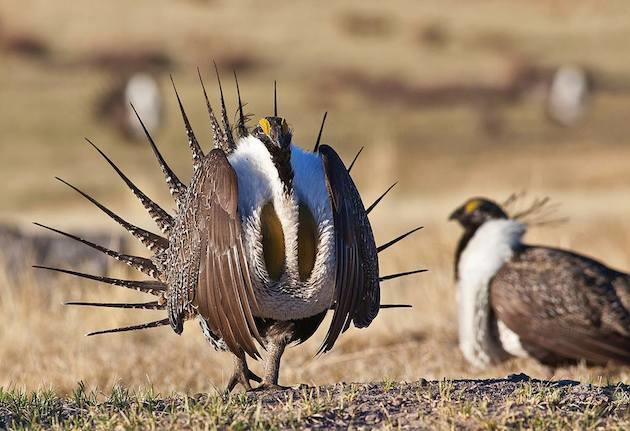Wildfire is raging across many of the western states as sage grouse await their fate.
The US Department of the Interior, the US Fish and Wildlife Service, the Utah Department of Natural Resources, the Bureau of Land Management, and the US Forest Service are among many organizations debating the bird’s potential listing on the Endangered Species Act. A deadline for the decision is set for September 30, and a consensus is still lacking.
Listing was first proposed in 2010, with major debate ensuing. A court ruling in 2011 gave the USFWS until the end of next month to make a decision.
The decision would list the greater sage grouse as a threatened species under the ESA. The greater sage grouse is a unique and charismatic species, albeit widely unrecognized by the general public. The bird stands up to two feet tall, with males weighing roughly five pounds. Females average two to three pounds.
Its name is derived from its diet of mainly sagebrush; the birds cannot exist in areas without it.
Sage grouse are famous for their mating ritual of drumming. Males gather at demonstration areas called leks to dance for females. As they do, two yellow sacks on the bird’s chest fill with air and allow it to produce a whistling, burping sound.
Several western states comprise the bird’s habitat range, including Utah and California, and would be affected by the decision. An ESA listing would include several restrictions for the area, including limits on oil and natural gas exploration, agriculture, and recreation.
Section 2 of the ESA reads: “The purposes of this Act are to provide a means whereby the ecosystems upon which endangered species and threatened species depend may be conserved, to provide a program for the conservation of such endangered species and threatened species ….”
The means used include land acquisition and prohibiting certain activities from occurring on the land. Listing would also make it harder for biologists to research the animals, as capturing and hands-on field techniques are restricted.
An article with the Deseret News said the total acreage that could be impacted is 163 million, with 583,000 acres of general habitat and 2.7 million acres of priority habitat in Utah alone. States complain that much of the areas the federal plan would preserve were marginal for grouse at best—some of it not viable at all.
An unusual alliance of state and economic entities has taken place as a result, as individual states, oil and gas companies, farmers, and cattle ranchers have united in their common goal of preventing the bird’s listing. Each has worked to improve the number of grouse in the western states in order to avoid the tougher restrictions an ESA listing would include. The joint efforts have had a noticeable effect on recent population surveys.
The US Department of Agriculture’s Natural Resources Conservation Service reported Monday that greater sage grouse populations had increased by two-thirds since 2013. The study was conducted by the Western Association of Wildlife and Fisheries Agencies.
“Our lek count data shows an increase in male sage grouse from 49,397 in 2013 to 57,399 in 2014 and 80,284 males in 2015,” San Stiver, WAFWA’s sage grouse coordinator, said in a USDA blog post August 17.
In 2006, the researchers found the highest number of birds per lek—33—in decades. That number decreased to 17 per lek in 2013, but 2014 saw the number rise to 18, and to 25 in 2015.
“I wouldn’t suggest this is a trend at this point, as it is not enough years for a trend, but it is clearly good news,” Stiver said. He told the Daily GPI, “The most important part of the data is that the numbers aren’t decreasing.”
Widespread burning has caused concern for the birds’ future. Much of the western United States is experiencing drought conditions and wildfires with thousands of acres of sagebrush potentially affected. The total acreage hasn’t been calculated, as fires continue to burn late into the summer, but the final count may play a part in the USFWS decision.
The debate is reminiscent of the northern spotted owl listing in the Pacific Northwest under the Clinton Administration. The spotted owl was listed as threatened under the ESA, with acres of habitat removed from logging operations as a result. Thousands of logging industry jobs were reportedly lost, with owl populations continuing to decline by roughly 7 percent each year in spite of the changes.
Many fear a similar situation will occur if the recent cooperation at the state level is quashed in favor of federal listing and management.
Greg Sheehan, director of the Utah Division of Wildlife Resources, told the Deseret News that the listing of greater sage grouse will be a major source of angst in his state and the grouse’s management region.
“It will change the world we live in in the West,” he said. “We will have a war in the West.”
This video provides a detailed look at how greater sage grouse drum.
Cover image: Thinkstock

